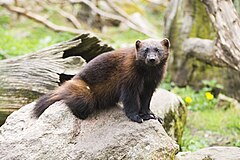Rosomak
| Gulo | |||
| Pallas, 1780[1] | |||
 Przedstawiciel rodzaju – rosomak tundrowy (G. gulo) | |||
| Systematyka | |||
| Domena | |||
|---|---|---|---|
| Królestwo | |||
| Typ | |||
| Podtyp | |||
| Gromada | |||
| Podgromada | |||
| Rząd | |||
| Podrząd | |||
| Infrarząd | |||
| Nadrodzina | |||
| Rodzina | |||
| Podrodzina | |||
| Rodzaj |
rosomak | ||
| Typ nomenklatoryczny | |||
|
Gulo sibiricus Pallas, 1780 (= Mustela gulo Linnaeus, 1758) | |||
| Synonimy | |||
|
| |||
| Gatunki | |||
| |||
Rosomak[4] (Gulo) – rodzaj ssaków z podrodziny Guloninae w obrębie rodziny łasicowatych (Mustelidae).
Zasięg występowania
[edytuj | edytuj kod]Rodzaj obejmuje jeden żyjący współcześnie gatunek występujący w Eurazji i Ameryce Północnej[5][6][7].
Morfologia
[edytuj | edytuj kod]Długość ciała (bez ogona) 65–105 cm, długość ogona 21–26 cm; masa ciała samic 6–12 kg, samców 11–18 kg[6][8].
Systematyka
[edytuj | edytuj kod]Rodzaj zdefiniował w 1780 roku niemiecki botanik i zoolog Peter Simon Pallas w publikacji własnego autorstwa poświęconej zoologii[1]. Gatunkiem typowym jest (oznaczenie monotypowe) rosomak tundrowy (G. gulo).
Etymologia
[edytuj | edytuj kod]Gulo: łac. gulo, gulonis ‘żarłok’, od gula ‘obżarstwo, apetyt’[9].
Podział systematyczny
[edytuj | edytuj kod]Do rodzaju należy jeden występujący współcześnie gatunek[10][8][5][4]:
- Gulo gulo (Linnaeus, 1758) – rosomak tundrowy
Opisano również gatunki wymarłe[11]:
- Gulo minor Sotnikova, 1982[12] (Azja; pliocen)
- Gulo schlosseri Kormos, 1914[13] (Ameryka Północna, Europa; plejstocen)
- Gulo sudorus Samuels, Bredehoeft & Wallace, 2018[14] (Ameryka Północna; pliocen)
Uwagi
[edytuj | edytuj kod]Przypisy
[edytuj | edytuj kod]- ↑ a b P.S. Pallas: Spicilegia zoologica: quibus novae imprimis et obscurae animalium species iconibus, descriptionibus atque commentariis illustrantur. Cz. 14. Berolini: Prostant apud Gottl. August. Lange, 1780, s. 25. (łac.).
- ↑ Anonim. Opinion 258. Rejection for nomenclatorial Purposes of the work by Frisch (J. L.) published in 1775 under the title Das Natur-system der Vierfüssigen Thiere. „Opinions and declarations rendered by the International Commission on Zoological Nomenclature”. 5, s. 55–72, 1954. (ang.).
- ↑ J.L. Frisch: Das Natur-System der Vierfüßigen Thiere. Glogau: Christian Friedrich Günther, 1775, s. 17. (niem.).
- ↑ a b Nazwy zwyczajowe za: W. Cichocki, A. Ważna, J. Cichocki, E. Rajska-Jurgiel, A. Jasiński & W. Bogdanowicz: Polskie nazewnictwo ssaków świata. Warszawa: Muzeum i Instytut Zoologii PAN, 2015, s. 156. ISBN 978-83-88147-15-9. (pol. • ang.).
- ↑ a b C.J. Burgin, D.E. Wilson, R.A. Mittermeier, A.B. Rylands, T.E. Lacher & W. Sechrest: Illustrated Checklist of the Mammals of the World. Cz. 2: Eulipotyphla to Carnivora. Barcelona: Lynx Edicions, 2020, s. 450. ISBN 978-84-16728-35-0. (ang.).
- ↑ a b S. Larivière & A.P. Jennings: Family Mustelidae (Weasels and relatives). W: D.E. Wilson & R.A. Mittermeier (red. red.): Handbook of the Mammals of the World. Cz. 1: Carnivores. Barcelona: Lynx Edicions, 2009, s. 627–628. ISBN 978-84-96553-49-1. (ang.).
- ↑ D.E. Wilson & D.M. Reeder (red. red.): Genus Gulo. [w:] Mammal Species of the World. A Taxonomic and Geographic Reference (Wyd. 3) [on-line]. Johns Hopkins University Press, 2005. [dostęp 2021-05-23].
- ↑ a b Class Mammalia. W: Lynx Nature Books: All the Mammals of the World. Barcelona: Lynx Edicions, 2023, s. 685. ISBN 978-84-16728-66-4. (ang.).
- ↑ T.S. Palmer. Index Generum Mammalium: a List of the Genera and Families of Mammals. „North American Fauna”. 23, s. 303, 1904. (ang.).
- ↑ N. Upham, C. Burgin, J. Widness, M. Becker, C. Parker, S. Liphardt, I. Rochon & D. Huckaby: Treeview of Mammalian Taxonomy Hierarchy. [w:] ASM Mammal Diversity Database (Version 1.11) [on-line]. American Society of Mammalogists. [dostęp 2023-12-20]. (ang.).
- ↑ J.S. Zijlstra, Gulo Pallas, 1780, Hesperomys project (Version 23.8.1), DOI: 10.5281/zenodo.7654755 [dostęp 2023-12-20] (ang.).
- ↑ М.В. Сотникова. К истории рода Gulo в Евразии. „Труды Зоологического института РАН”. 3, s. 138–145, 1982. (ros.).
- ↑ T. Kormos. Drei neue Raubtiere aus den Präglazial-Schichten des Somlyóhegy bei Püspökfürdö. „Mitteilungen aus dem Jahrbuche der königl. ungarischen Geologischen Reichsanstalt”. 22 (3), s. 223–247, 1914. (niem.).
- ↑ J.X. Samuels, K.E. Bredehoeft & S.C. Wallace. A new species of Gulo from the Early Pliocene Gray Fossil Site (Eastern United States); rethinking the evolution of wolverines. „PeerJ”. 6, s. e4648, 2018. DOI: 10.7717/peerj.4648. (ang.).
